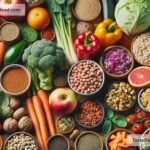Foods for Improving Dietary Patterns: Simple Tips for Healthier Eating
Eating well is one of the most important things you can do for your body and mind. Food gives us energy, helps us stay healthy, and keeps us feeling strong. Improving your dietary patterns doesn’t have to be complicated or expensive. In fact, simple, everyday foods can make a big difference to your overall health. This article will share easy-to-follow tips about which foods to include in your diet to support better eating habits.
Why Improving Your Diet Matters
The food we eat affects almost every part of our lives—from how we feel during the day to how well we sleep at night. A healthy diet helps prevent diseases like diabetes, high blood pressure, and heart problems. It can also boost your mood, improve digestion, and give your body the nutrients it needs to function effectively.
Changing your diet isn’t about strict rules or cutting out everything you enjoy eating. Instead, it’s about making small, consistent changes to include more nutritious foods in your daily meals.
What Foods Should You Eat More Often?
Here are some food groups that can improve your dietary patterns and make a difference in your health:
1. Whole Grains
Whole grains are packed with nutrients like fiber, vitamins, and minerals. Fiber is essential for good digestion, and it helps you feel full, so you’re less likely to snack on unhealthy foods. Swap out refined grains like white bread or white rice for whole-grain options such as:
- Brown rice
- Whole-wheat bread
- Oats
- Quinoa
- Barley
Whole grains provide steady energy and support heart health over time.
2. Fruits and Vegetables
Fruits and vegetables are superfoods when it comes to health. They are rich in vitamins, minerals, and antioxidants, which protect the body from damage and boost your immune system. They also contain fiber to aid digestion.
Aim to include a variety of colorful fruits and vegetables in your diet. Each color offers different nutrients—for example, orange foods like carrots and sweet potatoes provide vitamin A, while leafy greens like spinach and kale are loaded with iron and calcium. Try to eat:
- Fresh fruits like apples, oranges, and berries
- Vegetables like broccoli, peppers, and zucchini
- Frozen or dried options if fresh isn’t available
3. Healthy Proteins
Protein helps build muscles, repair tissues, and keep you feeling full for longer periods. It’s an essential part of any diet, but not all protein sources are created equal.
Choose lean proteins and avoid overly processed or fatty meats. Some great protein-rich options include:
- Eggs
- Chicken
- Fish (like salmon and tuna, which are rich in omega-3 fatty acids)
- Beans, lentils, and chickpeas (plant-based proteins)
- Nuts and seeds (like almonds or chia seeds)
If you’re vegetarian or vegan, plant-based proteins like tofu, tempeh, and legumes are excellent choices to meet your protein needs.
4. Dairy or Dairy Alternatives
Dairy products are great sources of calcium, which supports strong bones and teeth. Yogurt, milk, and cheese are common examples. If you’re lactose intolerant or prefer not to consume dairy, there are many alternatives available, such as almond milk, soy milk, and vegan cheeses.
Opt for unsweetened or low-fat versions of dairy products. Greek yogurt, for instance, is a wonderful source of protein and probiotics that support gut health.
5. Healthy Fats
Not all fats are bad! Healthy fats are important for brain function, heart health, and hormone balance. Avoid trans fats and limit saturated fats often found in fried or junk foods.
Instead, eat foods with healthy fats, such as:
- Avocados
- Olive oil
- Fatty fish (like mackerel or sardines)
- Nuts and seeds (such as walnuts or flaxseed)
These fats are good for your heart and provide long-lasting energy.
6. Hydrating Foods
Water is essential for life, but most people don’t drink enough of it. Besides drinking plenty of water, you can also eat hydrating foods to stay refreshed. Foods like cucumbers, watermelon, oranges, and celery contain high amounts of water and help you stay hydrated throughout the day.
What Foods Should You Limit?
While adding nutritious foods to your diet, it’s also helpful to cut back on foods that don’t contribute much to your health. For example:
- Sugary Snacks: Cookies, candy, and soda add extra sugar that can harm your teeth and lead to weight gain.
- Processed Foods: These are often high in salt, sugar, and unhealthy fats.
- Fast Foods: Burgers, fries, and fried chicken are tempting, but they’re usually loaded with unhealthy oils and calories.
- Alcohol: Too much alcohol can damage your liver and impact your sleep.
You don’t have to avoid these foods entirely—just eat them in moderation.
Tips for Improving Your Dietary Patterns
- Start Small: Changes don’t have to be dramatic. Begin by adding one new healthy food to your meals each week.
- Plan Your Meals: Preparing meals at home allows you to control the ingredients and portion sizes.
- Snack Wisely: Replace chips or candy with nuts, fruits, or yogurt.
- Read Labels: Look for hidden sugars, unhealthy fats, or high salt levels in packaged foods.
- Stay Consistent: Healthy eating is about balance. Don’t give up if you indulge in treats sometimes—just focus on maintaining a good pattern overall.
Conclusion
Improving your dietary patterns doesn’t have to feel overwhelming. By including more whole grains, fruits, vegetables, lean proteins, and healthy fats in your meals, you’ll make significant strides toward better health. Remember, eating better is a journey—not a sprint. Small changes today can lead to big improvements in how you feel tomorrow. So, start incorporating these foods into your diet and enjoy the benefits of a healthier lifestyle!


